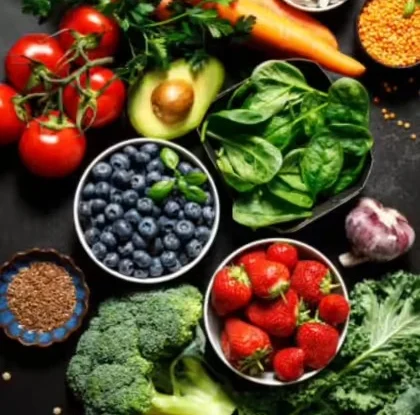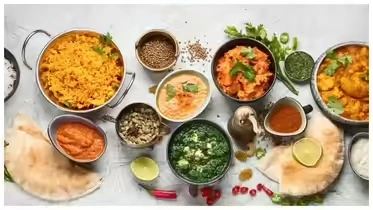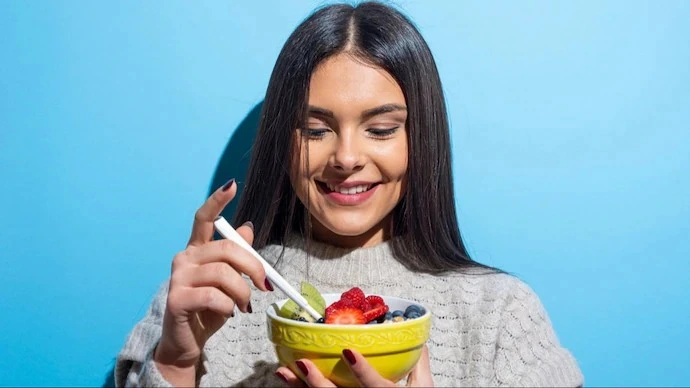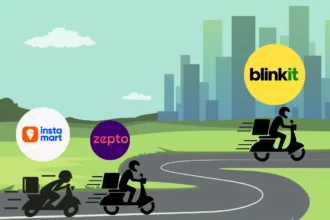Estimated Reading Time: 34-36 minutes ( 6,667 words)
Introduction
If you grew up in India, chances are your life has been shaped by a rotating committee of nutrition advisors — your grandma with her legendary home remedies, your mom with her “I read this in Femina magazine,” your gym bro quoting some YouTube coach, and of course, the ever-reliable WhatsApp University. From “Ghee will make you strong like Hanuman” to “Fruit after 6 PM becomes sugar poison,” the advice is endless… and sometimes hilarious. But the real question is: how much of this is actually true? Especially in a world where science is evolving faster than our myths can keep up?
Here’s the thing: nutrition myths aren’t just harmless desi quirks. Many of them can quietly shape the way we eat, think, and worry about food. Some myths push people into unnecessary guilt (“I should avoid rice or I’ll gain weight”), while others create overconfidence (“Ayurvedic herbs will fix everything, no matter what I eat”). In a country battling rising obesity, vitamin deficiencies, diabetes, and lifestyle disorders, misinformation isn’t just annoying — it’s dangerous. And amidst all the chaos, it’s easy to feel confused about what’s actually healthy.
That’s why in this blog, we’re breaking down the most popular Indian nutrition myths using real science, clear explanations, and practical, guilt-free guidance. No jargon. No lectures. Just easy, sensible truths you can apply right away. By the end, you’ll walk away knowing what to eat, what to ignore, and how to stop letting random forwards decide your diet. Brace yourself — some of these myths are about to get roasted.

Myth 1: “Desi Ghee Is Always Healthy”
The Myth
In many Indian households, desi ghee is treated like a miracle substance — the cure for everything from weak immunity to dry skin to poor digestion. Elders swear by it, fitness influencers glorify it, and Ayurveda-inspired marketing amplifies the idea that ghee is a superfood that melts fat, strengthens joints, and boosts overall vitality.
The Truth
Ghee absolutely has its place in traditional Indian diets, but the “eat as much as you want” narrative is misleading — and often harmful.
1. Ghee is extremely calorie-dense.
One tablespoon contains around 120 calories, and those calories come largely from saturated fat, which, when consumed in excess, can elevate LDL (“bad”) cholesterol.
As India Today reports, several nutrition experts warn that while ghee does contain some heart-friendly monounsaturated fats, its high proportion of saturated fat makes portion control crucial — especially for people with:
- sedentary lifestyles
- family history of cardiac issues
- high cholesterol
- obesity or fatty liver
2. Ghee does not “burn fat” or reduce belly size.
This popular claim has no scientific support. Ghee offers vitamins A, D, E, and K — which is great — but it doesn’t magically speed up metabolism or dissolve fat stores.
3. Adulteration is a real danger.
Reports in India Today highlight the prevalence of adulterated ghee mixed with dalda (vanaspati), vegetable oils, or cheap fats. These adulterants dramatically increase trans fat content, which is far worse for heart health than natural ghee.
This means even “pure-looking” ghee can be harmful unless bought from trusted sources or verified local producers.
4. Ghee is best when used consciously, not liberally.
Modern nutritionists recommend using ghee as a flavor enhancer, not a primary source of dietary fat.
Pairing it with whole grains or fiber-rich foods (like dal or roti) slows digestion and keeps portions in check. Slathering ghee over everything because “it’s healthy” often backfires.
Practical Tip
Enjoy ghee — but in small, intentional amounts.
1–2 teaspoons per day is appropriate for most healthy adults.
Use it where it shines: tadkas, parathas, dal, or occasional homemade sweets.
Just don’t depend on it for “health magic,” weight loss, or miracle cures.
Myth 2: “All Fat Is Bad”
The Myth
For decades, Indian households — especially older generations — have associated any type of fat with clogged arteries, heart attacks, and weight gain. The moment someone says they’re “dieting,” the first advice they hear is: “Oil mat khana, ghee band kar do, nuts avoid karo.”
This blanket fear comes from outdated nutrition trends of the 90s, when low-fat diets were hailed as the ultimate path to good health.
The Truth
Modern nutrition science paints a very different picture: fat is essential for the human body, and removing it entirely can do more harm than good.
1. Not all fats behave the same in the body.
Experts featured in India Today emphasize the need to differentiate between three major categories of fats:
- Healthy fats (Monounsaturated & Polyunsaturated)
Found in:
- olive oil
- mustard oil
- groundnut oil
- nuts and seeds
- avocados
- fatty fish (like salmon, mackerel)
These fats protect the heart, reduce inflammation, support hormonal balance, and improve cell health.
- olive oil
- Saturated fats (to be consumed in moderation)
Found in:
- ghee
- butter
- full-fat dairy
- certain meats
In small amounts, they’re fine — but excessive intake can raise LDL cholesterol.
- ghee
- Trans fats (the real villain)
Found in:
- bakery items (cakes, pastries, puffs)
- packaged namkeens
- deep-fried fast food
- dalda/vanaspati
- cheap street snacks
These fats increase inflammation, raise bad cholesterol, and significantly increase heart disease risk.
- bakery items (cakes, pastries, puffs)
2. Good fats are essential for key body functions.
Unsaturated fats help with:
- Brain function and memory
- Production of hormones
- Nutrient absorption (vitamins A, D, E, K require fat)
- Skin health
- Heart protection
Cutting these fats leads to dryness, fatigue, digestion issues, hormonal imbalance, and even weakened immunity.
3. Extremely low-fat diets often cause more harm.
According to NDTV Health experts, very low-fat diets can:
- Increase cravings
- Slow metabolism
- Trigger overeating later
- Cause blood sugar fluctuations
- Reduce meal satisfaction, making diets unsustainable
This is why people who remove fat completely often experience constant hunger or rebound weight gain.
Practical Tip
Don’t fear fat — choose smart fats and control portions.
- Use oils like olive oil, mustard oil, sesame oil, and groundnut oil in moderation.
- Include nuts, seeds, fatty fish, and limited ghee in your diet.
- Completely avoid trans-fat-rich foods like bakery items, vanaspati, and cheap fried snacks.
- Healthy eating is not “no fat.” It’s “the right fat, in the right amount.”
Myth 3: “Carbs Make You Fat”
The Myth
Rice is “the villain.” Potatoes are “fattening.” Roti at night? “Instant belly fat.”
This fear is so widespread in India that the moment someone starts a diet, they proudly declare:
“I’ve stopped eating carbs.”
Some even believe that cutting all carbs guarantees instant weight loss — an idea boosted by trendy low-carb and keto diets circulating on social media.
The Truth
Carbohydrates are not the enemy — they’re your body’s main source of fuel. Nutrition experts quoted in Mint emphasize that weight gain doesn’t come from carbs themselves, but from:
- Eating excess calories
- Poor food choices
- A sedentary lifestyle
- High refined carb intake
- Metabolic issues (like insulin resistance)
In reality, carbs support: - Brain function
- Stable energy levels
- Digestion (when fiber-rich)
- Healthy gut bacteria
- Athletic performance
What matters is carb quality, not carb fear.
1. The Real Problem: Refined Carbs, Not Carbs as a Whole
Refined carbs digest quickly, spike blood sugar, and cause hunger soon after eating.
Examples:
- White bread
- Maida-based rotis and parathas
- Bakery foods
- Biscuits and cookies
- Instant noodles
- Packaged breakfast cereals
- Sweetened beverages
These contribute to overeating and higher calorie intake — leading to weight gain over time.
2. The Good Guys: Complex Carbs
Complex carbohydrates digest slowly, provide sustained energy, and are packed with fiber, vitamins, and minerals. According to fitness experts at Care Fitness and leading Indian dietitians, they improve:
- Satiety
- Gut health
- Blood sugar control
- Nutrient absorption
- Energy stability
Examples of healthy complex carbs:
- Millets (ragi, jowar, bajra)
- Whole wheat
- Brown rice / red rice
- Quinoa
- Oats
- Lentils (dal)
- Legumes (chole, rajma, moong, soybeans)
- Potatoes and sweet potatoes (when not fried)
These foods are staples of Indian diets for a reason: they’re nutritionally dense and culturally suited.
3. Why Ultra Low-Carb Diets Fail for Most Indians
Keto, low-carb, or no-carb diets may show quick initial results, but long-term sustainability is poor — especially in Indian households where meals naturally center around rice, roti, dal, sabzi.
Common issues people face on extreme low-carb diets:
- Fatigue and brain fog
- Mood swings
- Poor digestion due to low fiber
- Muscle loss
- Cravings and binge eating
- Difficulty sticking to the plan
- Nutrient deficiencies
Most Indians eventually go back to their normal eating pattern — often regaining all the lost weight.
Practical Tip
Don’t eliminate carbs — balance them.
Use the “½–¼–¼ plate formula”:
- ½ plate: vegetables (fiber)
- ¼ plate: protein (enhances satiety)
- ¼ plate: complex carbs
This keeps meals satisfying without excess calories or glucose spikes.
Better options:
- Brown rice instead of white rice occasionally
- Roti made with mixed grains (jowar, ragi, bajra)
- Add dal/chole/rajma for protein
- Include a veggie sabzi to slow digestion
- Eat potatoes boiled or roasted, not fried
- Balanced carbs = better energy + easier weight control + sustainable lifestyle.
Myth 4: “Eating Fruit Spikes Blood Sugar / Is Bad for Diabetes”
The myth:
Many Indians — especially those living with diabetes or prediabetes — believe that fruits are “loaded with sugar.” Because fruits taste sweet, people assume they behave like sweets, mithai, or sugary drinks in the body. As a result, they completely avoid fruits, thinking it will protect their blood sugar.
The truth:
Nutritionists repeatedly clarify that whole fruits are not the enemy. Fruits contain natural sugar, but they also come packed with fiber, vitamins, minerals, antioxidants, and water content — all of which slow digestion and help stabilize glucose. Unlike added sugar found in colas, packaged juices, desserts, and processed foods, fruit sugar comes with a natural “buffer” that reduces how fast it hits the bloodstream.
For people with diabetes, the key is choosing the right fruits and the right quantity, not avoiding them altogether. Low- to medium-glycemic fruits such as guava, papaya, apple, pear, orange, pomegranate, watermelon (in moderation), strawberries, and muskmelon release glucose more slowly and are generally safe when eaten mindfully. Many nutritionists in India also point out that fruits contain polyphenols that can actually improve insulin sensitivity over time.
Another common issue: many Indians eat fruit at the wrong time, like after a heavy meal or along with sweets — which leads to higher spikes. The fruit isn’t the issue; the timing and context are.
What should be avoided:
Fruit juices, even homemade ones, remove fiber completely. Without fiber, sugar hits the bloodstream quickly, almost like drinking a sugary beverage. Packaged juices are even worse — high in added sugar and preservatives. Smoothies with too many fruits can also cause spikes.
Practical, India-friendly tips:
- Choose whole fruits over juices or smoothies. Chewing slows absorption and keeps glucose steady.
- Pair fruit with protein or fiber, such as a handful of nuts, seeds, curd, roasted chana, or a small serving of dal — this slows down sugar release.
- Stick to 1 medium-size fruit or 1 cup fruit per serving, rather than large bowls.
- Eat fruits mid-morning or as an evening snack, not immediately after meals.
- Prefer local, seasonal fruits — they are fresher, nutrient-rich, and often gentler on digestion.
Bottom line:
Fruits don’t cause diabetes — poor dietary patterns, inactivity, genetics, and excessive refined carbs do. Whole fruits, eaten correctly, can be a powerful part of a diabetes-friendly Indian diet.
Myth 5: “Sugar Alternatives Like Honey or Jaggery Are Automatically Healthier”
The myth:
Many Indians assume that switching from white sugar to honey, jaggery (gur), brown sugar, coconut sugar, molasses, or date syrup makes their food instantly “healthy.” Because these ingredients are “natural,” traditional, or used in Ayurveda-inspired recipes, people treat them as guilt-free sweeteners and add them liberally to tea, desserts, rotis, chikki, laddoos, and porridge.
The truth:
Nutrition experts emphasize that while honey and jaggery may contain trace minerals, antioxidants, or micronutrients, they are still concentrated forms of sugar — and your body breaks them down into glucose almost the same way as regular sugar. Studies quoted by dietitians in India note that honey and jaggery have high glycemic index (GI) values, meaning they can raise blood sugar quickly, especially in people with diabetes or insulin resistance.
- Honey: ~50–55% fructose + glucose; similar calories to sugar.
- Jaggery: Mostly sucrose; GI often higher than white sugar because it is less processed.
- Brown sugar: Essentially white sugar with molasses added back.
- Coconut sugar: Slightly lower GI, but not low enough to be “diabetic-friendly.”
- Date syrup/paste: Nutrient-dense but still sugar-heavy.
What many people misunderstand:
Even though these alternatives are “less processed,” the difference in nutrition is minimal unless you consume very large quantities, which you shouldn’t. Overuse — in tea, sweets, baked foods, halwa, laddoos, or “healthy” snacks — still contributes to calorie excess, weight gain, fatty liver risk, elevated blood sugar, and cravings.
“Natural” does not mean “safe to eat in unlimited amounts.” It simply means “derived from nature” — but poison ivy and tobacco are also natural. The health impact depends on quantity, not the label.
Practical, India-friendly tips:
- Use honey/jaggery sparingly, only for taste—not as a health supplement.
- Limit to 1–2 teaspoons a day if you must use them.
- Try spices that enhance sweetness naturally, such as cinnamon, cardamom, nutmeg, vanilla, or saffron, instead of adding more sugar.
- Reduce sweetness gradually — your taste buds will adapt within 2–3 weeks.
- Beware of “healthy” snacks marketed with jaggery (like granola bars, energy bites, millet laddoos). They can still be high-calorie desserts in disguise.
- Diabetics should treat honey and jaggery exactly like sugar and track post-meal glucose responses.
Bottom line:
Honey, jaggery, and “natural” sugars are not magical substitutes. They may offer slightly better flavor or micronutrients, but their effect on calories and blood sugar is nearly the same. Moderation is what matters — not the type of sweetener.
Myth 6: “Eggs Are Bad for Cholesterol”
The myth:
For decades, many Indians have believed that eggs — especially the yolk — drastically increase cholesterol and therefore must be eaten sparingly. This leads people to avoid yolks completely, restrict themselves to only 1–2 eggs a week, or fear giving eggs to older adults. The myth comes from old nutrition guidelines that linked dietary cholesterol directly to heart disease.
The truth:
Modern research paints a far more nuanced picture. While eggs do contain cholesterol (about 186 mg per yolk), nutritionists and cardiologists note that dietary cholesterol is not the primary driver of blood cholesterol. Instead, factors like genetics, overall diet quality, trans fats, refined carbs, visceral fat, sedentary behavior, and metabolic conditions have a much larger impact.
Studies reviewed by health experts (including those cited in ICICI Lombard’s wellness publications) show:
- For most healthy individuals, eating 1–2 whole eggs per day does not significantly raise LDL (“bad”) cholesterol.
- Eggs tend to raise HDL (“good”) cholesterol, which is protective.
- The body adjusts its internal cholesterol production depending on dietary intake.
- The saturated fat content of food contributes more to cholesterol imbalance than dietary cholesterol itself.
Nutritional benefits of eggs:
Eggs are extremely nutrient-dense:
- High-quality protein with all essential amino acids
- Vitamin B12, B2, B5
- Vitamin A and D (especially in the yolk)
- Choline — crucial for brain and liver function, often lacking in Indian diets
- Selenium and other antioxidants like lutein and zeaxanthin (good for eye health)
This makes eggs especially valuable for children, vegetarians who consume eggs, athletes, pregnant women, elderly adults, and people trying to increase protein intake affordably.
When caution is needed:
Some individuals may need moderated egg consumption:
- People with familial hypercholesterolemia
- People with genetic lipid disorders
- People with very high LDL levels not controlled by medication
- Those advised by cardiologists to follow specific low-cholesterol diets
Even for them, the focus is usually on overall diet — avoiding fried foods, processed foods, and saturated fats — rather than demonizing eggs alone.

Practical, Indian-friendly tips:
- If you are generally healthy, 1–2 whole eggs a day is safe, according to modern nutrition consensus.
- Avoid preparing eggs with excess oil, butter, or deep frying — the cooking method matters.
- If cholesterol levels are a concern, use 1 whole egg + 1–2 egg whites for balanced nutrition.
- Include eggs alongside high-fiber foods (vegetables, whole grains) to support lipid balance.
- Don’t remove yolks unless medically advised — the yolk contains half the protein and most of the vitamins.
- For seniors, eggs can help maintain muscle mass and prevent protein deficiency.
Bottom line:
Eggs are not villains. They are one of the most nutritious, affordable, and protein-rich foods available in India. For the vast majority of people, eggs do not significantly raise cholesterol—and avoiding them can lead to missing out on essential nutrients.
Myth 7: “Processed or Frozen Fruits & Vegetables Are Nutritionally Inferior”
The myth:
Many Indians firmly believe that anything fresh is automatically healthier, and anything frozen, canned, or dried is somehow “old,” “chemical-filled,” or “nutritionally dead.” This belief is common across households, especially because of cultural norms that favor fresh sabzis bought daily from local markets. As a result, people often avoid frozen peas, canned tomatoes, packaged corn, or dried fruits, assuming they’re inferior to fresh produce.
The truth:
This myth often oversimplifies how food processing works. Studies highlighted by India Today note that frozen and canned fruits/vegetables can be just as nutritious — and sometimes even more nutritious — than fresh produce, depending on how long the “fresh” produce has been sitting in transit. Here’s why:
- Frozen produce is usually frozen within hours of harvesting, locking in vitamins and antioxidants at their peak ripeness.
- “Fresh” produce in supermarkets may travel long distances, sit in storage for days, and lose nutrients during transport and handling.
- Canned foods like tomatoes, beans, or pineapple are heat-treated, which can reduce some heat-sensitive nutrients but preserves others — and makes foods shelf-stable and safe.
- Dried fruits (like apricots, raisins, dates) are nutrient-dense, portable, and rich in fiber and iron — making them valuable for Indian diets often low in micronutrients.
Experts at The Good Health Clinic emphasize that the real issue isn’t freezing or canning — it’s the additives. Some packaged products contain:
- Added sugar (in canned fruits or dried fruits)
- Excess sodium (in canned vegetables or tomato puree)
- Preservatives depending on the brand
But many modern brands also offer zero-preservative, low-sodium, no-added-sugar options if you read labels correctly.
Why this matters for Indian households:
- Seasonal produce prices fluctuate hugely; frozen/canned can help maintain nutrition affordably.
- Urban lifestyles mean people don’t always have time to chop vegetables daily.
- Frozen options reduce food waste — especially for nuclear families or single professionals.
- Some nutrients (like lycopene in canned tomatoes) may become more bioavailable after heat processing.
Practical tip:
Use a smart combination of fresh + frozen + canned + dried fruits and vegetables to balance convenience, cost, and nutrition. When buying packaged options:
- Choose products with no added sugar (for fruits).
- Pick low-sodium or no-added-salt variants (for vegetables or beans).
- Avoid syrupy canned fruits — choose items stored in water or natural juice.
- For dried fruits, choose unsulphured and unsweetened options.
Ultimately, frozen and canned produce aren’t the enemy — they’re extremely useful tools that make healthy eating simpler, more affordable, and more practical for modern Indian diets.
Myth 8: “High-Protein Diets Damage Kidneys”
The myth:
Across India, there is a long-standing belief that “too much protein”—especially from supplements like whey protein—puts a dangerous load on the kidneys. Many people think protein is only for bodybuilders and that everyday adults should avoid it to prevent “kidney failure.” This fear is especially common among older adults, gym beginners, and those influenced by viral social-media claims linking protein shakes to kidney stones or chronic kidney disease.
The truth:
Modern medical consensus is clear: for healthy individuals with normal kidney function, higher protein intake does NOT cause kidney damage.
This myth largely stems from misunderstanding how kidneys metabolize protein—or from isolated cases involving individuals who already had underlying kidney issues.
A recent clarification by an AIIMS neurosurgeon, reported in The Times of India, reinforces that this fear is massively overstated in India. According to the expert:
- The kidneys of a healthy person are fully capable of handling the increased workload associated with processing dietary protein.
- Problems arise only if the person already has reduced kidney function, chronic kidney disease (CKD), or uncontrolled diabetes/hypertension—which are the actual causes of kidney strain.
For the average adult—especially those who exercise, live sedentary lifestyles, or eat carb-heavy diets—protein deficiency is a more realistic risk than protein excess.
Why Indian diets need more protein, not less:
- Most Indian diets rely heavily on carbs (rice, wheat, potatoes).
- Studies show that many Indians consume only 0.6 g/kg/day of protein, far below the recommended 0.8–1.2 g/kg/day.
- Low protein intake contributes to fatigue, muscle loss, weaker immunity, hair fall, poor metabolism, and slower recovery from exercise.
Protein plays essential roles in:
- Muscle repair & growth (especially important in aging populations)
- Metabolism & fat loss (protein increases thermogenesis)
- Hormone and enzyme production
- Satiety (prevents overeating and sugar cravings)
- Immune function
So where does the kidney myth come from?
When individuals with undiagnosed kidney disease consume very high protein, the kidneys—which are already compromised—struggle to handle the load. This led to a blanket belief that protein is harmful for everyone.
But for a healthy person, science does NOT support this.
Practical tip:
If you’re a healthy adult with no diagnosed kidney issues, you can safely consume:
- Natural protein sources:
- Dal, chole, rajma, paneer, tofu, curd, chicken, fish, eggs, sprouts, soy
- Dal, chole, rajma, paneer, tofu, curd, chicken, fish, eggs, sprouts, soy
- Protein supplements (whey, plant-based protein) in moderate amounts if your diet falls short.
To stay safe and balanced:
- Aim for 0.8–1.2 g protein per kg body weight daily (higher if active).
- Spread protein intake across meals for better absorption.
- If you have diabetes, hypertension, or existing kidney issues, consult a nephrologist or dietitian before increasing protein intake.
Bottom line:
For most people, protein helps your body — it doesn’t harm your kidneys. The real danger is not eating enough of it.
Myth 9: “Gluten Is Harmful to Everyone”
The myth:
Thanks to global diet trends, celebrity endorsements, and viral Instagram reels, gluten has become one of the most misunderstood ingredients in Indian households. Many people now believe that gluten — a natural protein found in wheat, barley, and rye — is “inflammatory,” “toxic,” or “the cause of weight gain and bloating.” As a result, even perfectly healthy people switch to gluten-free rotis, millet-only diets, or expensive packaged gluten-free foods without understanding whether they actually need to.
The truth:
For the vast majority of Indians, gluten is completely safe.
Medical experts quoted in Mint emphasize that gluten becomes a problem only for:
- People with celiac disease (an autoimmune disorder where gluten damages the small intestine)
- Individuals with non-celiac gluten sensitivity (NCGS)
- Those with wheat allergy
These groups form a very small percentage of the population.
For everyone else, gluten-containing foods — particularly whole wheat — offer significant benefits:
- High dietary fiber, which aids digestion and supports gut health
- Complex carbohydrates, providing steady energy
- B vitamins, key for metabolism
- Minerals like iron, magnesium, zinc
- Protein, contributing to muscle repair and satiety
Ironically, unnecessary avoidance can do more harm than good.
Gluten-free alternatives often:
- Contain lower fiber
- Are more calorie-dense
- Include added starches (like tapioca, potato starch)
- Are expensive and over-processed
- Reduce traditional Indian dietary diversity
Cutting out wheat without medical need may lead to nutrient gaps, poor satiety, and over-reliance on processed gluten-free snacks.
Why self-diagnosing gluten intolerance is risky:
Bloating, fatigue, gas, or indigestion — symptoms people often blame on gluten — can be caused by:
- Lactose intolerance
- High-fat meals
- Poor gut health
- Excess salt
- Eating too fast
- IBS
- Stress
- Thyroid issues
Removing gluten without proper testing can mask the real issue and delay accurate diagnosis.
Practical tip:
If you genuinely suspect gluten intolerance:
- Don’t self-diagnose.
- Get medically evaluated with:
- Anti-tTG IgA blood test (for celiac screening)
- Endoscopy if required
- Doctor-guided elimination trials for NCGS
- Anti-tTG IgA blood test (for celiac screening)
If tests come back normal, feel free to enjoy:
- Whole-wheat rotis
- Multigrain atta
- Wheat-based dalia, upma, chapatis, parathas
- Millet breads (as part of variety, not as a forced replacement)
- Gluten is not the enemy — misinformation is.
Myth 10: “Skipping Meals Helps You Lose Weight”
The myth:
Many Indians believe that skipping breakfast, lunch, or dinner is a quick way to cut calories and shed weight faster. Social media trends, celebrity detox routines, and old fitness myths often reinforce the idea that “eating less often” automatically means losing fat. As a result, people skip meals, drink only tea or coffee, or survive on small snacks, thinking it will accelerate weight loss.
The truth:
Skipping meals rarely works as intended — and often backfires. Nutritionists and health experts cited by The Times of India note that skipping meals can trigger several negative outcomes:
- Overeating later: When you skip a meal, hunger hormones like ghrelin spike, making you more likely to overconsume at the next meal.
- Blood sugar fluctuations: Skipping meals can cause dips in glucose levels, leading to fatigue, irritability, poor concentration, and sugar cravings — a common complaint among Indians consuming carb-heavy meals.
- Slower metabolism: Prolonged fasting can reduce basal metabolic rate slightly, as the body tries to conserve energy. Over weeks, this may actually make weight loss harder.
- Muscle loss: Without regular protein intake throughout the day, the body may start breaking down muscle tissue, which is counterproductive if your goal is fat loss.
- Nutrient deficiencies: Skipping meals can reduce intake of essential vitamins, minerals, and fiber — especially in Indian diets that rely on frequent meals for balanced nutrients.
Contrary to popular belief, your body does not “store up” calories to burn them later. Weight management depends on total daily caloric intake, macronutrient balance, and activity levels, not meal-skipping alone.
Exceptions:
Intermittent fasting (IF) can work for some individuals, but it requires planning:
- Choose the 16:8 or 14:10 fasting window wisely.
- Ensure adequate protein, fiber, and healthy fats in the eating window.
- Stay hydrated with water, herbal teas, or black coffee.
- Avoid binge eating at the end of the fast — this negates calorie control.
Practical, India-friendly tips:
- Eat 3 balanced meals with healthy snacks if needed (fruits, nuts, sprouts, yogurt).
- Include protein + fiber + complex carbs in each meal for satiety.
- Breakfast: oats, poha, upma, or egg-based dishes with vegetables
- Lunch: dal, sabzi, roti/rice, salad, yogurt
- Dinner: lighter but balanced — soup, sabzi, grains, and lean protein
- If fasting, choose mid-morning or evening snacks wisely to maintain energy levels.
- Listen to your hunger cues — avoid eating out of boredom or stress.
Bottom line:
Skipping meals is not a shortcut to weight loss. Consistency, balanced nutrition, and portion control work far better — especially in Indian diets rich in carbs, spices, and traditional foods. Smart meal planning maintains energy, stabilizes blood sugar, and supports sustainable fat loss without unnecessary stress or deprivation.
Why These Myths Persist in Indian Culture
1. Cultural & traditional beliefs:
In India, food is more than nutrition — it’s tradition, emotion, and ritual. Items like ghee, jaggery, or certain spices carry nostalgia and symbolic value, often associated with health, strength, or prosperity. These cultural connections make people resistant to simple scientific critiques. When a food has been part of family recipes for generations, questioning it can feel like questioning tradition itself. (India Today)
2. Social media and influencer hype:
In today’s fast-paced digital world, viral diet trends and “superfood” claims spread rapidly. Unqualified influencers often promote extreme diets or foods as miracle solutions. With Instagram, YouTube, and WhatsApp forwards, myths gain momentum faster than scientific evidence can correct them.
3. Legacy advice from elders:
Advice passed down from parents and grandparents often blends traditional knowledge with outdated nutrition science. Phrases like “eat ghee for strong bones” or “avoid milk at night” are repeated across generations. While some advice has merit, it sometimes conflicts with modern scientific understanding.
4. Confusion from conflicting research:
Nutrition science evolves constantly. Headlines promoting low-carb, low-fat, or high-protein diets can contradict each other, leaving readers confused. Mixed messages make it hard for people to separate fact from myth, allowing misconceptions to persist.
Bottom line:
These myths endure because they combine culture, convenience, and confusion. Understanding why they persist is the first step toward making informed, evidence-based food choices in daily Indian diets.
How to Build a Balanced, Evidence-Based Indian Diet
Eating well doesn’t mean giving up your favorite foods — it means making informed, science-backed choices while respecting Indian culinary traditions. Here’s how you can align your meals with evidence without sacrificing taste or culture:
1. Start with a diet assessment:
Track your meals for a week — write down what you eat, portion sizes, and meal timings. Identify areas where myths might be influencing your choices, such as avoiding eggs, skipping meals, or using excessive ghee. Understanding your baseline helps you make practical changes instead of guessing.
2. Prioritize whole foods:
Focus on vegetables, legumes, whole grains, fruits, nuts, and seeds. In the Indian context, this means:
- Lentils and dals (moong, masoor, chana)
- Whole-wheat rotis, brown rice, millets (jowar, bajra, ragi)
- Seasonal fruits like guava, papaya, and berries
- Nuts and seeds (almonds, flaxseeds, sunflower seeds)
Whole foods provide fiber, vitamins, minerals, and antioxidants that packaged or refined foods often lack.
3. Use fats wisely:
Healthy fats are essential for brain function, hormones, and nutrient absorption. Include nuts, seeds, avocado, and olive or mustard oil, while keeping traditional fats like desi ghee in moderation. Avoid excessive fried foods and trans-fat-rich snacks (like packaged namkeens).
4. Balance macronutrients:
Aim for a mix of carbohydrates, proteins, and fats at each meal:
- Carbs (whole grains, millets) for energy
- Protein (dal, paneer, eggs, yogurt, fish) for muscle repair and satiety
- Fats (nuts, ghee, oil) for hormone regulation and nutrient absorption
Balancing macronutrients keeps energy levels stable, reduces sugar cravings, and supports weight management.
5. Stay hydrated:
Proper hydration aids digestion, appetite control, and metabolism. Opt for:
- Water (8–10 glasses/day)
- Buttermilk or chaas
- Coconut water
- Low-sugar herbal teas
Avoid sugary drinks that spike blood sugar and empty calories.
6. Consult experts when needed:
If you’re unsure about portions, supplements, or medical conditions like diabetes or kidney issues, speak to a registered dietitian or certified nutritionist. Evidence-based guidance ensures safety and efficacy.
7. Question blanket claims:
Be skeptical of statements like “this food burns fat” or “honey is completely safe because it’s natural.” Look for peer-reviewed studies, government guidelines (like FSSAI), or expert advice before changing your diet.
8. Educate your family:
Many myths come from older generations. Share evidence-based nutrition knowledge respectfully with parents, grandparents, or children. Use practical examples — like how eggs provide protein without harming cholesterol — to dispel misconceptions.
Bottom line:
A balanced Indian diet is flexible, nutrient-rich, and culturally compatible. By tracking meals, prioritizing whole foods, using fats wisely, and questioning myths, you can build a diet that supports health, energy, and longevity without feeling restrictive.
Key Facts
| Myth | Reality |
| Ghee raises cholesterol | Excess saturated fat can increase LDL; use in moderation. India Today |
| Natural sugar is harmless | Honey & jaggery have similar glycemic load to sugar. The Times of India |
| Carbs = weight gain | Complex carbs plus balanced macros help maintain healthy weight. Care Fitness |
| Fruit spikes blood sugar | Whole fruits (especially low-GI) are fine for diabetics with portion control. India Today+1 |
| High protein harms kidneys | For healthy individuals, moderate-to-high protein is safe. |
FAQs Section
1. Is ghee really bad for health?
No — ghee can be part of a healthy Indian diet when used in moderation. One tablespoon of ghee contains roughly 120 calories and is rich in saturated fats. Nutritionists in India Today caution that excessive consumption may raise LDL (“bad”) cholesterol, especially in populations with already high cholesterol levels.
Practical tip: Use 1–2 teaspoons per day, preferably in traditional dishes (like dal tadka or rotis) rather than drenching your meals. Choose trusted brands or homemade ghee to avoid adulteration with vanaspati or vegetable oils.
2. Can diabetics eat fruit?
Yes — diabetics can enjoy whole fruits, particularly low-glycemic options like guava, papaya, apple, pear, orange, and berries. Whole fruits contain fiber, vitamins, antioxidants, and natural sugars that are absorbed slowly, helping maintain steady blood glucose.
Avoid: Fruit juices, canned fruits in syrup, or smoothies with added sugar.
Practical tip: Pair fruit with protein or fiber (nuts, yogurt, dal) to further moderate glucose response. Recommended serving: 1–2 portions/day, individualized per doctor advice.
3. Are all fats unhealthy?
Absolutely not. Fats are essential for brain health, hormone production, nutrient absorption (A, D, E, K), and satiety.
- Healthy fats: Olive oil, mustard oil, avocado, nuts, fatty fish, limited ghee.
- Unhealthy fats: Trans fats (found in packaged snacks, bakery items, vanaspati/margarine).
- Practical tip: Replace fried or trans-fat-rich foods with unsaturated fats, and use traditional fats like ghee sparingly.
4. Will skipping meals help me lose weight?
No — skipping meals often backfires, causing:
- Overeating later due to increased hunger hormones (ghrelin)
- Blood sugar fluctuations
Reduced metabolism over time
Studies (The Times of India) confirm that consistent, balanced meals with appropriate portion sizes support sustainable weight management.
Practical tip: Eat 3 balanced meals + 1–2 healthy snacks; intermittent fasting may work if done thoughtfully with hydration and nutrient balance.
5. Does “natural” sugar (honey or jaggery) mean it’s safe?
No — natural sugars are still sugar. Honey and jaggery have similar caloric content and glycemic impact as refined sugar. Overconsumption contributes to calorie excess and blood sugar spikes. (Times of India)
Practical tip: Use natural sweeteners sparingly. Enhance flavor with spices like cinnamon, cardamom, nutmeg, or cocoa instead of relying on sweeteners.
6. Is high protein bad for kidneys?
Not for healthy individuals. Moderate-to-high protein intake is safe, as confirmed by AIIMS experts and nutritionists. Kidney damage risk applies mainly to people with pre-existing kidney disease, hypertension, or diabetes.
Practical tip: Include dal, paneer, yogurt, eggs, chicken, fish, tofu, or moderate whey protein. Aim for 0.8–1.2 g protein per kg body weight daily, distributed across meals.
7. Do frozen or canned fruits/vegetables lack nutrition?
No — when frozen or canned properly, nutrients are preserved, sometimes better than “fresh” produce that has been stored or transported for days. (India Today)
Tips:
- Check labels for added sugar or salt.
- Mix fresh, frozen, and canned produce to reduce food waste and increase convenience.
- Frozen peas, corn, or berries are excellent for year-round nutrition at affordable prices.
8. Should I avoid gluten completely?
Only if you have celiac disease or non-celiac gluten sensitivity. Otherwise, gluten-containing grains (wheat, barley, rye) are nutritious and provide fiber, protein, B vitamins, and sustained energy. (Mint)
Practical tip: Avoid self-diagnosing. If concerned, get blood tests or doctor evaluation before eliminating gluten. Incorporate whole-wheat rotis, multigrain breads, and millet varieties for diversity.
9. Are eggs bad because of cholesterol?
No — eggs do contain dietary cholesterol, but most healthy adults do not experience harmful increases in blood cholesterol from moderate consumption. Eggs are also rich in protein, choline, B vitamins, and antioxidants, supporting muscle and brain health. (ICICI Lombard)
Practical tip: 1–2 eggs/day are safe. Use more egg whites if cholesterol is a concern.
10. How do I know which nutrition advice to trust?
Look for credentialed sources:
- Registered dietitians or certified nutritionists
- Peer-reviewed scientific studies
- Government guidelines (FSSAI, ICMR, WHO)
Avoid relying solely on social media trends, viral diets, or celebrity claims. When in doubt, consult a qualified professional for individualized guidance.
Bottom line:
These FAQs dispel common myths while providing practical, India-friendly strategies. Following evidence-based nutrition helps maintain energy, health, and metabolic balance without falling prey to misinformation.
Summary / Key takeaways
- Diabetes is rising globally and in India — India has ~90 million adults with diabetes (2024). Diabetes Atlas
- Technology — CGM, DTx, telemedicine, AI and insulin-delivery innovations — are key levers to improve monitoring, prevention, and outcomes. Grand View Research+1
- Cost, supply, and rural access are major constraints; policy and insurer support will determine reach in the next decade. The Times of India+1
- For bloggers: product reviews (CGM, apps), prevention guides, and lead magnets are high-value content that can monetize via affiliates, sponsored content, and webinars.

Conclusion
India stands at a pivotal moment in its battle against diabetes. The country faces one of the world’s fastest-growing diabetes burdens, driven by genetics, lifestyle transitions, urban diets, and an aging population. Yet unlike a decade ago, India now has access to a powerful ecosystem of technologies — Continuous Glucose Monitoring (CGM), smart insulin delivery, digital therapeutics, AI-driven risk prediction, remote monitoring, and wearables that contextualize glucose with daily habits. These tools do more than track numbers; they bring real-time insight, enable early intervention, and help patients prevent complications long before they reach critical stages. For millions of Indians who struggle with access, literacy, or affordability, the emergence of telemedicine and hybrid-care models means specialist-level support can finally reach small towns and rural clusters.
However, technology alone isn’t the solution. The bigger challenge lies in equity, affordability, and proper medical supervision. Many advanced devices remain expensive, insurance coverage is limited, and awareness gaps persist — especially in Tier-2/3 towns where diabetes is rising fastest. Without guided interpretation and doctor-led oversight, even the best CGM or app can mislead users or create false confidence. India needs a blended model where tech supports clinicians, not replaces them, and where mass-market education campaigns help people understand how to use these innovations safely and effectively. Long-term success will depend on reducing device costs, strengthening primary care, expanding government screening programs, and ensuring that digital tools are localized for Indian diets, languages, and cultural nuances.
For content creators, healthcare startups, educators, and entrepreneurs, this space represents a rare blend of high search demand, evergreen relevance, and meaningful social impact. Diabetes-related queries, reviews, comparisons, and tech explanations attract millions of monthly searches. Brands are actively seeking affiliate partnerships, creators are building communities around health optimization, and India’s policy push towards digital health adds momentum. By producing accurate, well-researched, clinically responsible content, creators can shape public understanding, help users adopt the right technologies, and contribute to a nationwide shift toward prevention-based healthcare. This is not just a trending niche — it’s a long-term, high-value category that will grow for years as India transforms how it manages chronic disease.
References & Sources
(Select authoritative sources used to write this article — include links on publish)
- International Diabetes Federation (IDF) — India country data, 2024. Diabetes Atlas+1
- Lancet / NCD Risk Factor Collaboration reports & Reuters coverage on 800+ million adults with diabetes (2024). Reuters+1
- Grand View Research — India Continuous Glucose Monitoring Devices Market Report (2024–2033). Grand View Research
- Mordor Intelligence — India CGM Market (estimates 2025). Mordor Intelligence
- WHO — Diabetes in India overview. World Health Organization
- Ministry of Health & Family Welfare (India) — NP-NCD / NPCDCS program guidelines. Ministry of Health and Family Welfare+1
- Recent journal reviews on AI and digital therapeutics in diabetes (summaries / industry reports). Mordor Intelligence+1
- News reporting on insulin access & local studies (example coverage). The Times of India+1
I’ll include a full reference list with exact URLs and (where needed) date accessed in the final CMS publish-ready file.







